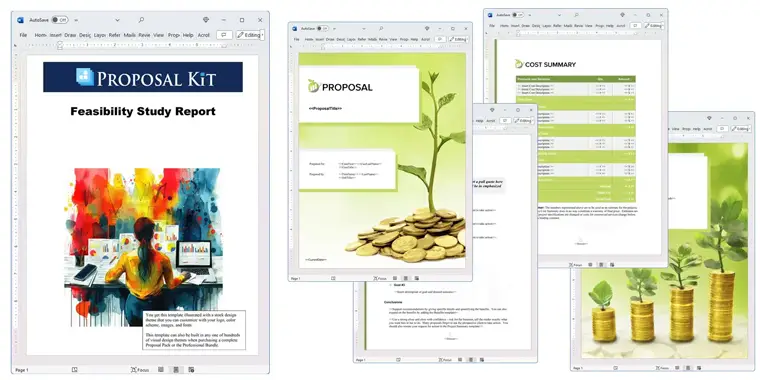How to write your Feasibility Study Report
We include this 16 page layout with every Proposal Pack. If you want this template to have a different visual design theme than the one illustrated here, purchase any Proposal Pack design and create this template using the purchased design theme. This template is included in every Proposal Pack. If you get a Proposal Pack or the Professional, you can also make any variation of this template with different chapters to suit your needs.
We typically include more chapters in the templates than most people will need to give everyone more variety in the chapters they may need. You can trim down a long template by removing pages you do not need or combining multiple chapter topics into one page.
 DOWNLOADABLE, ONE-TIME COST, NO SUBSCRIPTION FEES
DOWNLOADABLE, ONE-TIME COST, NO SUBSCRIPTION FEESThis sample proposal is based on the same layout as this template and is included in every Proposal Pack. The visual design of the templates will match whichever Proposal Pack design you purchase. To get this template in a different design theme than shown in the sample, purchase any other Proposal Pack design theme and this template will be included.
You can create an editable Word version of this sample in any design theme of your choice including branded to your logo.
You can also create countless variations of this document to suit your needs using the included library of 2200+ chapters if ordering a Proposal Pack or Professional.
 What Our Clients Say
What Our Clients SayThe packs have really helped us to obtain these business contracts, and without them we would still be scratching our heads for ideas. This was the best investment that we have made to enable our company to grow."
Related Article
Related Video
Related Templates
- Feasibility Study and Analysis
- Feasibility Study for Business Startup
- Franchise Purchasing Proposal
- Business Case Document
- Internship Report
- Standard Operating Procedure Document
- SWOT Analysis Report
- Case Study Report
- Annual Report
- Reserve Study
What's the Best Way to Write Your Feasibility Study Report?
A proven way to write your feasibility study report is to use the Proposal Kit template and software package. This powerful tool simplifies the process, providing detailed templates and step-by-step guidance to create a professional and comprehensive feasibility study report.
Why Use Proposal Kit for Your Feasibility Study Report?
Using the Proposal Kit template library and Wizard software program is the ideal solution for those unfamiliar with writing business documents. Proposal Kit offers a structured approach to creating detailed documents like feasibility study reports, ensuring all necessary components are included. Additionally, the software incorporates a line item quoting database system for cost summaries, quotes, estimates, budgets, and other financial topics, streamlining the financial analysis aspect of your report.
Are You Facing the Challenge of Writing a Feasibility Study Report?
You're not alone if you need to write a feasibility study report. Many people face the same challenge and feel overwhelmed by the complexity of the task. Using Proposal Kit can help you navigate this process efficiently and effectively.
What Types of Projects Are Feasibility Study Reports Written For?
Feasibility study reports can be applied to a wide range of projects. Here are ten examples:
- Launching a new retail store
- Opening a restaurant
- Developing a mobile app
- Starting a manufacturing unit
- Establishing an online marketplace
- Initiating a renewable energy project
- Setting up a consulting firm
- Creating a healthcare clinic
- Introducing a new product line
- Expanding into international markets
Chapters this template is built with
There is no one-size-fits-all template that will work for all use cases. However, Proposal Kit's extensive library offers thousands of chapters that can be customized to fit your specific needs. Here is a starting point with critical components you can include
This list of chapter templates is just a small selection of the thousands available in Proposal Kit's library. You can customize your proposal to cover all necessary topics. Each template is a Word document that can be saved as a PDF for delivery once completed.
Introduction
The introduction sets the stage for your feasibility study report by providing a clear and concise overview of the project's purpose, scope, and objectives. This section is crucial as it informs readers about the context and rationale behind the study. A well-written introduction explains why the study is being conducted, its aims, and how it will be conducted. Proposal Kit's templates help you structure this section effectively, ensuring you include all necessary details. You can highlight the need for the study by discussing market opportunities or challenges that the project addresses. By outlining the specific goals and setting expectations for the survey, you create a strong opening that engages your audience and provides a roadmap for the rest of the document.
Needs Assessment
A needs assessment identifies the requirements and gaps that the project aims to address. This section is essential for demonstrating the importance and relevance of your project. Proposal Kit's templates guide you through detailing these needs, helping you communicate the problem your project intends to solve. You can discuss the current deficiencies in the market, unmet customer needs, or operational inefficiencies that your project will address. By providing a thorough needs assessment, you lay the foundation for justifying the project's necessity and potential impact. This section sets the stage for proposing solutions and gaining stakeholder support.
Trends
Analyzing current trends in your industry provides context for your feasibility study. This analysis helps stakeholders understand the external factors influencing your project and how your project aligns with or capitalizes on these trends. Proposal Kit's templates allow you to present this information in a structured manner, covering various aspects such as technological advancements, consumer behavior shifts, regulatory changes, and economic conditions. By highlighting relevant trends, you can demonstrate your project's relevance and potential for success in the current market landscape. This section helps build a case for why your project is timely and sound.
Present Situation
Describing the present situation involves outlining the current state of your industry or market. This section provides a snapshot of the existing conditions and sets the stage for your feasibility study. Proposal Kit's templates assist you in detailing this information, including market size, key players, competitive landscape, and recent developments. By providing a clear and comprehensive overview of the present situation, you establish a solid foundation for your feasibility study report. This context helps readers understand the baseline conditions and the environment in which your project will operate, making assessing its potential impact and feasibility easier.
Research
Market research involves gathering and analyzing data about your target market to inform your business decisions. Proposal Kit offers templates that make presenting your findings in a professional format easy. These templates help you organize and interpret data on market size, trends, customer preferences, and buying behavior. Using these templates, you can create a comprehensive market research report that provides valuable insights into your target market, helping you make informed decisions about your business strategy. This section is crucial for demonstrating that your project is based on solid data and a thorough market understanding, enhancing its credibility and feasibility.
Alternatives
Considering alternatives ensures you have explored all potential options for your project. This section involves identifying different approaches to achieve your project's goals and evaluating their feasibility. Proposal Kit's templates guide you in presenting various alternatives, discussing their pros and cons, and explaining why the chosen approach is the best option. By including this analysis, you show stakeholders that you have thoroughly evaluated possible solutions and selected the most viable one. This strengthens the credibility of your feasibility study and demonstrates your commitment to finding the best solution for the project's objectives.
Viability
Assessing the viability of your project involves analyzing its feasibility from various angles, including financial, technical, and operational perspectives. Proposal Kit's templates help you organize this analysis and present a comprehensive view of your project's potential success. This section examines the project's resources, capabilities, and risks. By providing a detailed viability analysis, you help stakeholders understand the project's strengths and potential challenges. This information is crucial for making informed decisions about whether to proceed with the project and identifying areas requiring additional attention or resources.
Cost/Benefit Analysis
A cost/benefit analysis compares your project's projected costs and benefits. This analysis helps stakeholders understand the project's financial implications and potential returns. Proposal Kit's templates assist you in detailing this comparison, ensuring you provide a thorough financial analysis. This section includes estimates of initial investment, operating costs, and expected revenues or savings. By presenting a clear and detailed cost/benefit analysis, you demonstrate the financial feasibility of your project and provide stakeholders with the information they need to evaluate its potential value. This analysis is crucial for gaining support and securing funding for your project.
Recommendations
Your recommendations summarize your findings and suggest the best course of action based on your feasibility study. Proposal Kit's templates help you articulate your recommendations effectively. These templates guide you through synthesizing your analysis, highlighting key insights, and presenting actionable suggestions. Using these templates, you can create clear and persuasive recommendations that support your business strategy and provide a roadmap for implementation. This section helps stakeholders understand the next steps and the rationale behind your proposed actions, making it easier for them to make informed decisions and commit to the project.
Future Potential
Outlining your project's potential helps stakeholders understand its long-term benefits and growth prospects. Proposal Kit's templates guide you in presenting this information compellingly. This section includes projections of market expansion, revenue growth, and potential opportunities for scaling the project. By highlighting the future potential, you demonstrate the project's sustainability and ability to generate long-term value. This information is crucial for building confidence in your project's viability and attracting long-term investments and support.
Facilities
Detailing your facility's needs is essential for planning and budgeting your business's physical space requirements. Proposal Kit's facilities templates help you present this information comprehensively. These templates guide you through identifying facility requirements, estimating costs, and planning for space utilization. Using these templates, you can create a detailed facilities plan that ensures your business has the necessary physical infrastructure to operate effectively. This section helps stakeholders understand the logistical aspects of your project and ensures that all physical requirements are accounted for.
Strategic Position
Analyzing your position involves assessing your competitive advantage and market positioning. Proposal Kit's templates help you present this analysis clearly, highlighting how your project stands out in the market. This section evaluates your unique selling points, competitive strengths, and market opportunities. You demonstrate your project's potential to succeed in a competitive environment by providing a detailed position analysis. This information is crucial for differentiating your project from competitors and convincing stakeholders of its value.
Feasibility Study
The core of your document, the feasibility study itself, compiles all the research, analysis, and recommendations into a cohesive report. Proposal Kit's templates ensure your feasibility study is well-organized and professionally presented. This section integrates all the above components into a comprehensive document that provides a complete assessment of your project's feasibility. Using Proposal Kit's templates, you can ensure that your feasibility study is thorough, coherent, and persuasive, making it easier for stakeholders to understand and support your project.
Conclusion
Writing a feasibility study report is essential in evaluating your venture's viability and success potential. Proposal Kit templates and software packages provide the guidance and structure needed to create a professional and comprehensive feasibility study report. Whether launching a new retail store, developing a mobile app, or starting a non-profit project, Proposal Kit has the resources to help you succeed. With the right tools, you can confidently present your feasibility study report, impress stakeholders, and move forward with your business startup plans.
Use cases for this template
Securing Investor Backing for a New Retail Store
Emily, a small business owner in the retail industry, dreamed of opening a second store to expand her growing business. She knew she needed a thorough feasibility study to convince potential investors of the project's viability. Without prior experience in writing such documents, Emily turned to Proposal Kit.
Using the Proposal Kit, Emily structured her feasibility study with clear and comprehensive sections. She began with a detailed market research analysis, using Proposal Kit's templates to gather and present data on customer demographics, shopping habits, and market trends. Next, she conducted a competitive analysis, identifying the strengths and weaknesses of nearby retail stores. Proposal Kit's templates helped her organize this information into a coherent and persuasive format.
Emily then tackled the financial projections, another area where the Proposal Kit proved invaluable. The templates guided her through estimating startup costs, operating expenses, and projected revenues. The Proposal Kit's line-item database calculated and built the financial tables into the document. Emily presented her plan with a clear and professional feasibility study to potential investors.
Meeting Tight Deadlines with AI and Proposal Kit
James, an employee at a tech company, faced a daunting task: conducting a feasibility study for a new AI SaaS within a very tight deadline. The pressure was immense, but James knew he could rely on the Proposal Kit and an AI writing tool to meet the challenge.
James started by using the Proposal Kit to outline the key sections of his feasibility study. He leveraged the templates to structure his market research, competitive analysis, and financial projections. James used an AI tool to draft specific chapters to speed up the writing process. He generated content by prompting the AI to analyze his company's website and extract relevant information.
James compiled a well-organized and professional feasibility study with the Proposal Kit's templates and the AI's assistance. He met his deadline, and the management team was thoroughly impressed with the quality and depth of his analysis.
Securing Funding for a Non-Profit Community Project
Sarah, a director at a non-profit organization, was tasked with writing a feasibility study for a new community project to provide educational resources to underserved areas. The success of this project was crucial, but Sarah needed more experience writing feasibility studies. She turned to the Proposal Kit for guidance.
Proposal Kit's templates provided Sarah with a clear roadmap for her feasibility study. She started by outlining the project's objectives, using templates to define the goals and expected outcomes clearly. Next, she conducted market research to understand the community's needs and the project's potential impact. Proposal Kit's structured templates made it easy for Sarah to present her findings.
Sarah then analyzed the potential challenges and risks associated with the project, outlining contingencies and mitigation strategies using the Proposal Kit's templates. The final step was to detail the financial aspects, including budgeting and funding requirements, using the Proposal Kit software's line-item database. Sarah's comprehensive and well-organized feasibility study secured the necessary funding and support from stakeholders, allowing the community project to move forward successfully.
Conclusions and Recommendations
Writing a feasibility study report is essential in evaluating your venture's viability and success potential. Proposal Kit templates and software packages provide the guidance and structure needed to create a professional and comprehensive feasibility study report. With the right tools, you can confidently present your feasibility study report, impress stakeholders, and move forward with your business startup plans.
Also Known As
This template may also be referred to in different ways or be used in more specialized situations, such as:
- Feasibility Analysis
- Project Viability Assessment
- Feasibility Evaluation
- Feasibility Assessment Report
- Project Feasibility Study
- Business Feasibility Review
- Feasibility Appraisal
- Viability Study
- Feasibility Investigation
- Feasibility Research Report
Abstract
 Creating a feasibility study report is an important step in determining the success potential of a proposed project. Using the Proposal Kit offers an efficient way to construct a comprehensive and professional report. This resource simplifies the process for project managers by providing a structured template library and Wizard software, which guide users through a detailed analysis phase.
Creating a feasibility study report is an important step in determining the success potential of a proposed project. Using the Proposal Kit offers an efficient way to construct a comprehensive and professional report. This resource simplifies the process for project managers by providing a structured template library and Wizard software, which guide users through a detailed analysis phase.
The report includes key components such as a market survey, technical feasibility study, market feasibility, and operational feasibility. By conducting a thorough feasibility assessment, you evaluate the practicality of a proposed business venture, considering factors like market demand, financial resources, and technical requirements.
Such studies involve a preliminary analysis of economic feasibility, legal feasibility, and potential market risks, ensuring alignment with the organization's goals and legal requirements. The template assists in preparing important documents like a projected income statement and an opening day balance sheet, factoring in expected costs and financial costs. Additionally, it considers human resources and technical resources important for project implementation. With a focus on environmental impact and regulatory concerns, the feasibility study evaluates the technical and operational feasibility of the new project.
 The Proposal Kit aids in identifying viable business alternatives and assessing long-term viability, thus supporting decision-making. It equips users with the tools to review and analyze similar proposals, ensuring that the project's benefits outweigh potential issues. By integrating feedback from relevant stakeholders, the feasibility study helps refine the project plan, making it a technically feasible and practically viable undertaking. This comprehensive approach not only enhances the likelihood of business success but also secures the confidence of venture capitalists, lending institutions, and community boards.
The Proposal Kit aids in identifying viable business alternatives and assessing long-term viability, thus supporting decision-making. It equips users with the tools to review and analyze similar proposals, ensuring that the project's benefits outweigh potential issues. By integrating feedback from relevant stakeholders, the feasibility study helps refine the project plan, making it a technically feasible and practically viable undertaking. This comprehensive approach not only enhances the likelihood of business success but also secures the confidence of venture capitalists, lending institutions, and community boards.
A feasibility report serves as a vital tool in project management, guiding the early stages of a particular project by examining various feasibility factors. It is important to assess the practicality of a proposed plan, including its market feasibility study, financial feasibility study, and legal feasibility study. These studies ensure that the project aligns with the business plan and organizational goals while conforming to applicable laws and environmental regulations. Organizational resources are evaluated to determine the required tools, technological considerations, and staffing requirements necessary for successful project execution.
A comprehensive feasibility study template enables project managers to conduct a market survey, preparing them to address potential risks and identify key benefits. This includes assessing the project's potential market share and determining the viability of the proposed business organization. For instance, expansion plans for a science facility might necessitate a detailed analysis of zoning laws, purchasing land, and environmental considerations. Such studies provide a framework to develop a contingency plan, ensuring that the project remains resilient against unexpected challenges.
 Incorporating a detailed economic feasibility study can assist in creating a robust marketing strategy, enhancing the project's appeal to stakeholders, including school officials and government entities. The feasibility assessment checklist offers a structured approach to identify viable alternatives, evaluate the expected return on investment, and ensure that the project is financially sound. Employing best practices, such as using Gantt charts to manage schedules and resources required, helps streamline operations and improve project efficiency.
Incorporating a detailed economic feasibility study can assist in creating a robust marketing strategy, enhancing the project's appeal to stakeholders, including school officials and government entities. The feasibility assessment checklist offers a structured approach to identify viable alternatives, evaluate the expected return on investment, and ensure that the project is financially sound. Employing best practices, such as using Gantt charts to manage schedules and resources required, helps streamline operations and improve project efficiency.
Furthermore, an operational feasibility study evaluates the project's long-term viability, factoring in labor, competition, and technical development. This assessment is crucial for identifying potential benefits that align with the organization's objectives and for ensuring that the project is worth pursuing. By addressing constraints and using technical and financial expertise, project managers can prepare for real work that brings significant progress and real change.
Ultimately, a well-prepared feasibility report not only facilitates informed decision-making but also serves as a business case that justifies investment in new business ventures or concepts. Whether the endeavor involves launching a new product or service, developing a science building, or catering to new students, such reports provide a roadmap for achieving success while navigating the complexities of modern business environments.
 A well-written feasibility study report is indispensable in today's dynamic business environment, providing a structured assessment of a project's practicality and long-term viability. These reports often serve as feasibility study examples, illustrating how to plan a business organization while considering its business legal structure and organizational structure. By examining various types of feasibility studies, such as technical, financial, and operational, project managers can identify the necessary organizational resources and appropriate stakeholders to involve.
A well-written feasibility study report is indispensable in today's dynamic business environment, providing a structured assessment of a project's practicality and long-term viability. These reports often serve as feasibility study examples, illustrating how to plan a business organization while considering its business legal structure and organizational structure. By examining various types of feasibility studies, such as technical, financial, and operational, project managers can identify the necessary organizational resources and appropriate stakeholders to involve.
The process includes defining the project's goals and identifying the required technology and equipment. This preparation involves several steps, such as detailing the description of the product or service and assessing the project's potential market impact. For school administrators considering a new concept, like a science building, these reports explore zoning issues and other legal considerations, ensuring compliance with regulations.
Using suggested components, a feasibility study includes identifying key factors that determine the project's feasibility. Gantt charts and other tools aid in managing timelines and resources, facilitating an organized approach to implementing the project. As real work begins, it's crucial to prepare for potential challenges, such as financing and equipment procurement, over several months.
Investing effort in such studies is an important step in minimizing risks and maximizing success. By digging deeper into feasibility factors, organizations can align projects with their goals and determine their viability. This requires a comprehensive assessment of both potential benefits and obstacles, allowing stakeholders to make informed decisions.
Ultimately, a feasibility study is not just about approving or rejecting a project; it's about understanding the project's role within the broader organizational framework. It includes evaluating the organization's interest in pursuing a new venture, using skills and investing in the necessary services. The assessment of the practicality of any proposed project ensures that, when the real work begins, the project is feasible, well-planned, and poised for success.
Frequently Asked Questions
What is a feasibility study report, and why is it important?
A feasibility study report is a document that evaluates the practicality and potential success of a project or business idea. It examines various aspects such as technical feasibility, financial viability, market potential, and legal considerations to determine whether the project should proceed. This report is crucial because it helps decision-makers understand the risks and benefits of the project, enabling them to make informed choices. By leveraging the power of the Proposal Kit, you can use a range of customizable templates that guide you through each section of the feasibility study report.
What should be included in a feasibility study report?
A comprehensive feasibility study report should include several key components: an executive summary, project description, market analysis, technical feasibility, financial analysis, legal and regulatory considerations, and risk assessment. Proposal Kit provides templates that cover all these sections, offering prompts and examples to help you fill in each part effectively. This ensures that your report is well-organized and covers all necessary aspects of the feasibility study.
How can I effectively analyze the financial viability of a project in a feasibility study report?
Effectively analyzing the financial viability of a project involves assessing the costs, revenue projections, profitability, and potential return on investment. Proposal Kit's templates include sections for detailed financial analysis, helping you break down the costs associated with the project, such as initial investment, operating expenses, and expected income. These templates also provide tools for conducting cost-benefit analysis, cash flow projections, and financial forecasting.
How can I ensure that my feasibility study report is comprehensive and covers all necessary aspects?
To ensure that your feasibility study report is comprehensive, you need to systematically evaluate all critical factors that could impact the project's success. Proposal Kit offers a structured approach through its templates, which include predefined sections for every important aspect of a feasibility study. These sections guide you to cover technical feasibility, market potential, financial analysis, legal considerations, and risk assessment thoroughly. Additionally, Proposal Kit's templates provide checklists and prompts to ensure that no details are overlooked.
How can Proposal Kit help streamline writing a feasibility study report?
Proposal Kit streamlines the process of writing a feasibility study report by offering a comprehensive library of templates and an intuitive software package. These resources guide you through each step of the report creation process, ensuring that all necessary components are included and professionally presented. The templates are customizable, allowing you to tailor them to your project needs. Proposal Kit also provides sample reports and examples that can serve as references, helping you understand how to structure and format your report effectively. This saves time and ensures that your report meets high standards of clarity and professionalism, making it easier to communicate your findings.
20% Off Discount
![]() Add To Cart This Word Template
Add To Cart This Word Template
 Add To Cart Proposal Pack Accounting #2
Add To Cart Proposal Pack Accounting #2
 Add To Cart Proposal Kit Professional
Add To Cart Proposal Kit Professional
 4.7 stars, based on 849 reviews
4.7 stars, based on 849 reviewsProposal Kit chapters used in this template
Title Page, Table of Contents, Introduction, Feasibility Study, Present Situation, Strategic Position, Needs Assessment, Trends, Facilities, Research, Alternatives, Viability, Future Potential, Cost/Benefit Analysis, Recommendations, Back Page
Line Item Automated Chapters
If you purchase a Proposal Pack or the Professional Bundle, these proposal pages are generated using an automated line-item database in the included Wizard software.
Cost Benefit Analysis
You use this proposal for
- Internal company proposal
- Business opportunity, partnership proposal
- Business document, study, plan, report
- IT, software, hardware proposal
How to create this template with Proposal Pack Wizard
You can create this document using any of the logo-designed Proposal Packs. Pick any Proposal Pack with a logo design theme you like best; they will all work equally well. The Proposal Pack for Any Business is the pack with no extra added logos or colors - designed to be used plain or for you to customize with your logos and graphics.
The Proposal Pack design theme you purchase will determine the visual look of this template. The screenshot above only shows the plain generic design theme.
We include a library of chapters to be assembled based on your needs. All proposals are different and have different needs and goals. We designed Proposal Pack so you can customize the documents to suit your needs.
You will best create this document using the Proposal Pack Wizard - Expert Edition software to select this template and build it in the Proposal Pack logo design theme of your choice along with any desired customizations (such as adding additional chapters, removing unneeded chapters, changing the order of chapters, and importing your company logo). This template outlines a proposal for the described situation. Each user is responsible for typing in the actual content of the provided pages with their information to complete the proposal. Suggestions in the abstract may include features in higher-end packages and are facilitated by the selection of chapter templates to support the narrative of each proposal, which help guide the user in filling in the details.
The Wizard software's AI Writer will write the content of the pages of the template based on details provided for your company, client, project, financial details and other writing instructions. This will provide a personalized version of the template completely written and ready to edit.
Once finished, the AI Writer's Word-to-PowerPoint converter can transform your proposal, business plan, or other business documents into a PowerPoint slideshow. Save time and effort by letting the AI analyze every chapter to condense its content into talking points, visually matching the document, and providing a consistent package of presentation material with the click of a button.
You create this template using the Wizard software with an entire Proposal Pack library and software. We include the Expert Edition of the software in the Proposal Kit Professional. Microsoft Word for Windows is required to use the customizing software. You can also edit Word document templates in other office software such as Word for Mac. We will assist Mac users in assembling complex templates for their first project if they do not have the required platform to run the Wizard software.
How to Build Templates Featured on Proposal Kit Website
Many people find the Proposal Kit website after searching for a specific proposal. Once you've purchased and installed the software, how do you build that template you found in the first place? This video shows you how to build any proposal you see on the Proposal Kit website.
 Ian Lauder has been helping businesses write their proposals and contracts for two decades. Ian is the owner and founder of Proposal Kit, one of the original sources of business proposal and contract software products started in 1997.
Ian Lauder has been helping businesses write their proposals and contracts for two decades. Ian is the owner and founder of Proposal Kit, one of the original sources of business proposal and contract software products started in 1997.By Ian Lauder
 Published by Proposal Kit, Inc.
Published by Proposal Kit, Inc.


 Cart
Cart
 Get 20% off ordering today:
Get 20% off ordering today: 


 Facebook
Facebook YouTube
YouTube Bluesky
Bluesky Search Site
Search Site